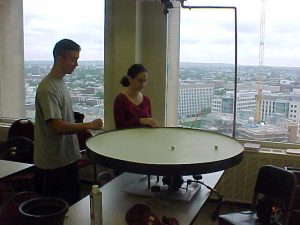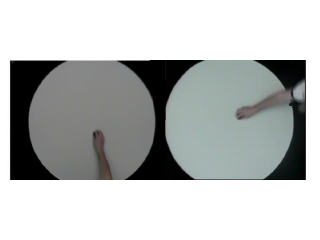GFDLab V: Inertial Circles – visualizing the Coriolis force
For a detailed description of this experiment, along with attendant theory, click here.
The Coriolis force can be visualized by making use of the parabolic surface constructed in Lab IV. If the ball at rest in the rotating frame, is given a push, it is deflected to the right.
We can experiment further by forming a `puck’ from a 1/2 inch diameter disc cut from rods of `dry ice’. The gas sublimating off the bottom almost eliminates frictional coupling between the puck and the surface of the parabolic dish.
Play games with the puck and study its trajectory on the parabolic turntable, both in the rotating and laboratory frames. Notice that when the puck moves in the rotating frame it is deflected to the right. The following are useful reference experiments:

- launch the puck so that it is motionless in the rotating frame of reference – it will follow a circular orbit around the center of the dish in the laboratory frame.
- launch the puck on a trajectory that lies within a fixed vertical plane containing the axis of rotation of the parabolic dish. Viewed from the laboratory the puck moves backwards and forwards along a straight line (the straight line will expand out in to an ellipse if the frictional coupling between the puck and the rotating disc is not negligible). When viewed in the rotating frame, however, the trajectory appears as a circle tangent to the straight line. See the movie loop below.
- the puck is again launched so that it appears stationary in the rotating frame, but is then slightly perturbed. In the rotating frame the puck undergoes oscillations consisting of small circular orbits passing through the initial position of the unperturbed puck. These circles are called `inertial circles’
Click here to show the movie loop, from which a frame is shown below: on the left we see the puck in the non-rotating frame, on the right we see the same puck but in the rotating frame.

Trajectory of the puck on the rotating parabolic surface in (a) the inertial frame and (b) the rotating frame of reference. The parabola is rotating in an anticlockwise (cyclonic) sense.
Study the theory behind the experiment here.